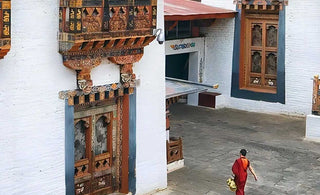
Thangka painting, a revered tradition in Tibetan Buddhist culture, has woven a rich tapestry of spiritual narratives and artistic expressions over centuries. As we delve into the evolution of Thangka culture, this exploration encompasses five distinct aspects that highlight the innovations and modernizations shaping this ancient art form.
1. Historical Roots: Nurturing Tradition Amidst Change
The journey of Thangka culture begins with its historical roots, deeply embedded in the spiritual practices of Tibetan Buddhism. Originating in the Himalayan region, Thangkas initially served as portable devotional images, capturing the essence of Buddhist teachings. Despite the passage of time, artists have preserved and transmitted this sacred tradition, maintaining a delicate balance between adherence to tradition and openness to change.
The Menbris Sama style, a distinctive artistic tradition within Thangka culture, has its roots deeply embedded in Tibetan Buddhism. Characterized by meticulous details, vibrant colors, and a profound spiritual symbolism, Menbris Sama has historically been associated with depicting deities, mandalas, and sacred narratives. However, the "Wealth Old Tibetan Antique Thangka" takes a bold step beyond the conventional, infusing this traditional style with contemporary themes.
2. Technological Advancements: From Pigments to Pixels
In recent years, technological advancements have left an indelible mark on Thangka painting. Traditional mineral pigments, sourced from the earth, are now complemented by modern materials, expanding the artist's palette. The integration of digital tools has revolutionized the creation process, allowing for intricate details and vibrant colors that push the boundaries of traditional techniques. This synergy of tradition and technology reflects the adaptability of Thangka culture in the face of a rapidly changing world.
3. Contemporary Themes: Beyond the Spiritual Realm
While rooted in Buddhist spirituality, Thangka culture has evolved to embrace contemporary themes. Artists are increasingly exploring topics beyond the religious spectrum, addressing social, political, and environmental issues. This expansion of subject matter not only reflects the artists' engagement with the modern world but also positions Thangka painting as a dynamic medium for expressing universal concerns and narratives.
Traditionally, Thangkas were revered as sacred objects with spiritual significance. The "Wealth Old Tibetan Antique Thangka" disrupts this paradigm by exploring the concept of wealth from a worldly perspective. The canvas becomes a visual narrative of prosperity, depicting scenes of abundance, opulence, and material well-being. This departure from the spiritual realm is a testament to the evolving consciousness of Thangka artists, who engage with contemporary realities while maintaining the stylistic integrity of Menbris Sama.
Within this antique Thangka, every stroke and symbol serves as a conduit for social commentary. The artists ingeniously integrate traditional symbols of wealth with modern elements, creating a layered visual language that speaks to the complexities of contemporary society. Golden motifs reminiscent of ancient treasures coexist with symbols of modern affluence, such as skyscrapers and luxury cars. This juxtaposition prompts viewers to reflect on the evolving nature of wealth and its impact on society across different eras.
4. Globalization: Thangka Beyond Tibetan Borders
In the age of globalization, Thangka culture has transcended geographical boundaries. Beyond its traditional Himalayan homeland, Thangkas have found appreciation and practitioners worldwide. This global diffusion has led to a cross-cultural exchange, influencing not only the artistic style but also the interpretation of Thangka symbolism. As diverse communities engage with Thangka painting, the art form undergoes a continuous evolution, shaped by the amalgamation of varied perspectives and cultural influences.
Beyond its exploration of prosperity, the "Wealth Old Tibetan Antique Thangka" delves into political themes, challenging the traditional apolitical stance of Thangka art. The canvas becomes a canvas for political commentary, with subtle references to power structures, governance, and the influence of wealth on political landscapes. Through symbolic imagery and allegorical representation, the Thangka becomes a mirror reflecting the artist's perception of the intersection between wealth and political dynamics.
5. Educational Initiatives: Preserving Tradition Through Teaching
The evolution of Thangka culture is intricately linked to educational initiatives aimed at preserving and transmitting this ancient art form. Institutes and workshops dedicated to Thangka painting have emerged, providing a structured platform for aspiring artists to hone their skills. These educational endeavors not only ensure the continuity of traditional techniques but also encourage innovation and experimentation, fostering a new generation of Thangka painters equipped to navigate the intersection of tradition and modernity.
As the Thangka engages with contemporary concerns, it doesn't shy away from addressing environmental issues. The canvas portrays a harmonious relationship between wealth and nature, emphasizing the importance of environmental consciousness. Traditional symbols of fertility and abundance coalesce with depictions of a pristine natural environment, urging viewers to contemplate the interconnectedness of material prosperity and ecological sustainability.
Conclusion: A Living Canvas of Tradition and Innovation
In conclusion, the evolution of Thangka culture unfolds as a living canvas where tradition and innovation coalesce. From its historical roots to the embrace of contemporary themes, technological advancements, globalization, and educational initiatives, Thangka painting continues to be a dynamic expression of spirituality and artistic creativity. The resilience of this ancient tradition lies in its ability to adapt without losing the essence of its sacred purpose, making Thangka culture a testament to the enduring dialogue between the past and the present. As we navigate the ever-changing landscape of the art world, Thangka painting stands as a vibrant testament to the harmonious coexistence of tradition and modernity.

Wealth Old Tibetan Antique Thangka Purely Hand-painted Menbris Sama Style























